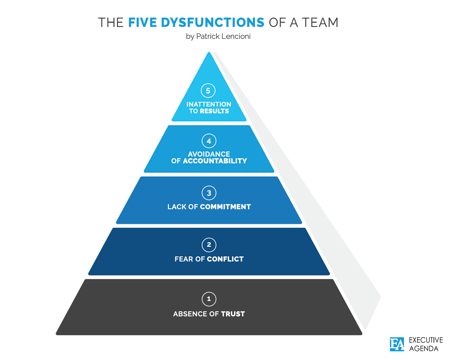If you could sit down with your 25-year-old self and tell them what’s coming, what would you say?...
Why Great Teams Are So Hard to Build—And What You Can Do About It
We all want to work on great teams, so why is it so hard to build one?
I’ve led and worked alongside incredible teams over the years, and I’ve learned this: even the most talented, well-intentioned people can struggle to function effectively as a unit. That’s why Patrick Lencioni’s The Five Dysfunctions of a Team has stuck with me for years. I appreciate what it reveals about team dynamics, but also what it surfaces in each of us about how we show up as teammates and leaders.
It’s one of the frameworks I return to again and again, especially when something feels “off” on a team, even if the people are strong and the stakes are high.
When Harmony Backfires
One of the most powerful realizations I had while studying this model came when I looked at the second dysfunction: fear of conflict.
I used to see my ability to maintain harmony as a core leadership strength. I valued peace, built strong relationships, and knew how to navigate differences. What I hadn’t realized was that this very instinct—so helpful in many moments—could also get in the way. I misunderstood what Lencioni meant by conflict.
His version isn’t about friction for friction’s sake or personal tension. It’s about healthy, constructive debate. It’s about having the kind of trust in your team that allows people to challenge ideas, raise concerns, and pressure-test decisions before everyone aligns around a direction.
Without that kind of healthy conflict, something more dangerous happens: People stay quiet. They fake agreement. They nod along while privately disagreeing.Eventually, accountability slides and results suffer.
My First Coaching Experience: A Lack of Trust
My first experience with executive coaching didn’t start with a desire to grow. It started with dysfunction.
I was part of a leadership team made up of strong, capable individuals. On paper, we had all the right ingredients: experience, intelligence, drive. In practice, however, we weren’t operating as a team. We were a group of leaders working in parallel, not in unison.
We didn’t fully trust that we could make decisions together and then stand behind them together. Too often, decisions made in the room unraveled afterward. Alignment didn’t stick, commitments got second-guessed, and slowly, confidence eroded.
That experience was a turning point. Coaching helped me understand that no amount of individual talent can compensate for the absence of trust. Until we built that foundation, real collaboration—and real results—were out of reach.
The Chain Reaction
What I’ve come to appreciate is how each dysfunction in Lencioni’s model is sequential. Each one builds on the last:
Trust → Conflict → Commitment → Accountability → Results
If your team doesn’t trust one another, they won’t engage in honest conflict. Without conflict, there’s no true commitment—just quiet, passive buy-in. Without commitment, it becomes harder to hold one another accountable. And when accountability breaks down, so do results.
It’s a chain, and any weak link drags the whole system down.
What to Watch For
Teams often misdiagnose where things are breaking down. A lack of accountability, for example, might look like a performance issue, but more often, it’s a symptom of a deeper breakdown in trust or commitment.
That’s why I encourage leaders and team members alike to think systemically. If something feels off—if decisions stall, engagement drops, or results plateau—ask yourself:
-
Is there real trust on this team?
-
Are people willing to speak up, challenge each other, and engage in productive conflict?
-
Do we have clarity and commitment around our goals?
-
Are we holding one another accountable in meaningful, respectful ways?
-
And finally, are we actually getting the results we want?
The Takeaway
You don’t need to be a senior executive to influence team health. Every team member plays a role in building trust, modeling openness, and inviting honest dialogue.
But it does take intention. Great teams don’t happen by accident.
So here’s the question I keep asking myself and one I encourage you to explore with your team:
Where does your team get stuck?
And as a leader or contributor, what’s your part in it?




